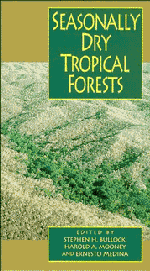Book contents
- Frontmatter
- Contents
- List of contributors
- Acknowledgements
- 1 Introduction
- 2 Dry forests of Central America and the Caribbean
- 3 Overview of the Brazilian caatinga
- 4 Savannas, woodlands and dry forests in Africa
- 5 Dry forest ecosystems of Thailand
- 6 The Cenozoic record of tropical dry forest in northern Latin America and the southern United States
- 7 Diversity and floristic composition of neotropical dry forests
- 8 Vertebrate diversity, ecology and conservation in neotropical dry forests
- 9 Diversity of life forms of higher plants in neotropical dry forests
- 10 Drought responses of neotropical dry forest trees
- 11 Plant reproduction in neotropical dry forests
- 12 Plant–herbivore interactions in Mesoamerican tropical dry forests
- 13 Biomass distribution and primary productivity of tropical dry forests
- 14 Nutrient cycling in tropical deciduous forests
- 15 Biology of the belowground system of tropical dry forests
- 16 Nitrogen trace gas emissions in a tropical dry forest ecosystem
- 17 Conversion of tropical dry forest to pasture and agriculture
- 18 Ethnobotany of the Mexican tropical dry forests
- Index
18 - Ethnobotany of the Mexican tropical dry forests
Published online by Cambridge University Press: 07 September 2010
- Frontmatter
- Contents
- List of contributors
- Acknowledgements
- 1 Introduction
- 2 Dry forests of Central America and the Caribbean
- 3 Overview of the Brazilian caatinga
- 4 Savannas, woodlands and dry forests in Africa
- 5 Dry forest ecosystems of Thailand
- 6 The Cenozoic record of tropical dry forest in northern Latin America and the southern United States
- 7 Diversity and floristic composition of neotropical dry forests
- 8 Vertebrate diversity, ecology and conservation in neotropical dry forests
- 9 Diversity of life forms of higher plants in neotropical dry forests
- 10 Drought responses of neotropical dry forest trees
- 11 Plant reproduction in neotropical dry forests
- 12 Plant–herbivore interactions in Mesoamerican tropical dry forests
- 13 Biomass distribution and primary productivity of tropical dry forests
- 14 Nutrient cycling in tropical deciduous forests
- 15 Biology of the belowground system of tropical dry forests
- 16 Nitrogen trace gas emissions in a tropical dry forest ecosystem
- 17 Conversion of tropical dry forest to pasture and agriculture
- 18 Ethnobotany of the Mexican tropical dry forests
- Index
Summary
Introduction
Human life is sustained and enriched by the surrounding vegetation. The exploitation of the local vegetation is one aspect of human relationship with plants. The interactions between humans and plants may result in beneficial as well as deleterious effects.
Ethnobotany may be defined as the study of the biological bases of plant-human interactions and relationships at different levels of organization (e.g. ecosystem, community, individual), over geographic and social space, and along the evolutionary time scale. On one hand, the lifestyle and form of subsistence of inhabitants can be strongly influenced by the exploitation of local plants as well as by introduced elements (e.g. cultigens) and processes (e.g. livestocking). The diversity and availability of vegetal resources depends upon the local demand to make a living as well as the external demands for raw material. Intensification of certain extractive or ecologically non-compatible processes often destroys over time valuable and promissory resources. For the purpose of this chapter, I consider only the spontaneous plants which are exploited for local consumption rather than the cultivated exotics or the systems that modify the habitat for ecologically non-compatible production.
The tropical dry forest (tropical deciduous forest, ‘selva baja caducifolia’ or ‘bosque tropical caducifolio’ and associated vegetation types) extends along the length of Mexico, principally parallel to both the Gulf of Mexico and the Pacific Ocean coasts (see Murphy & Lugo, Chapter 2). It ranges from 0 to 1900 m in elevation and covers 157,800 km2 (or 8% of the Mexican territory) (Rzedowski, 1978). Flores et al. (1971), on the other hand, estimate that the Mexican tropical dry forest (‘selva baja caducifolia’) occupies 315,213 km2 (or 16% of the country).
- Type
- Chapter
- Information
- Seasonally Dry Tropical Forests , pp. 423 - 438Publisher: Cambridge University PressPrint publication year: 1995
- 15
- Cited by



